![[Metroactive Features]](/features/gifs/feat468.gif)
![[Metroactive Features]](/features/gifs/feat468.gif)
[ Metro | Metroactive Central | Archives ]
Surf & Turf
Men Against Nature: Surfers head for the waves at Steamers Lane, Santa Cruz's premier surf spot.
The waves in Santa Cruz pack a mean punch. So do the surfers who ride them.
By Bob Hansen
THIS COULD GET UGLY. I just cut off some young kid in a neon yellow wetsuit, one of those expensive designer models that says: I'm hot. Kids like this have usually seen one too many surf videos and take offense when some burnout from the '70s drops in on them, as I just did.
He sits on his surfboard at Steamers Lane, barking at me like an angry sea lion. It's early December and biting cold. He seems upset because I landed on top of him as I was perfecting my takeoff technique out at the point. Well, that's what he gets for taking off behind me, I figure.
"What are you, some kind of idiot?" he sputters.
"Get lost, kook," I respond.
"Kook?! You're the kook, man. Why don't you go home?"
"I live and work here, buddy," I proudly point out, although I work in high tech and only recently moved here from Silicon Valley.
"Yeah, well I went to Santa Cruz High."
He's got me beat there. We glower at each other for a few seconds and then we both paddle off. From the cliff above someone shouts, "Can't we all just get along?" From the water, several guys yell back, "No!"
Welcome to surfing in the '90s, Santa Cruz style.
Surf's Up Online:
If the sharks and monster waves don't get a
Surfing websites makes it easy to go from
SURFING is more popular than ever these days. Even on bad days there are dozens of surfers out at the major spots, many of whom have managed to sneak away from their desk jobs. If a swell hits on a weekend or holiday, forget it. With the increase in crowds has come an increase in fights, verbal nastiness and accidents.
My encounter could easily have ended in a fight. If the kid hadn't been half my age and in much better shape, I might even have tossed the first punch. It gets intense out there at times.
"Steamers is one of the heaviest crowd conditions anywhere in the world," says Chuck Reed, 52, a longtime surfer and member of the Santa Cruz Longboard Union, a club formed in the '80s to promote the spirit of surfing.
Last year, an attempt of sorts was made to ease the tensions in the water. At Reed's urging, the Santa Cruz Parks and Recreation Department posted a sign at Steamers with the "rules of surfing." The sign declares, "First surfer on wave has right-of-way," and it cautions riders to "hang on to your board" and "help other surfers." It's located at the top of the stairs across from the bathrooms at Lighthouse Point, which overlooks Steamers.
The sign is actually an updated version of the "traditional rules of surfing" first posted at Steamers back in the '60s by the late Santa Cruz surf god Sam Reid. That sign disappeared years ago.
The new rules, of course, have no teeth. The moral compass of each surfer determines whether he or she will follow them. But the idea, Reed says, was to post them for the benefit of newcomers, specifically the increasing number of "middle-agers" who want to surf but lack any knowledge of the sport's unwritten code of ethics.
"Those newcomers are probably pretty nice, but they don't know what the rules are and that can be dangerous," Reed says. "Those rules are something you grew up with or learned the hard way."
But just as most driving disputes end with someone flipping someone else off instead of pointing a gun, surf disputes typically end with a few choice words: Learn to surf. Go home. Fuck off.
In the lineup, the best surfers get all the best waves. It's that simple. At Steamers, they take off right at the peak, where the waves first feel the drag of the reef. On big days the peak gets downright hairy, with frightening elevator drops and giant sucking barrels. And then there's the cliff. Out at the point, the waves slam into the cliff with tremendous power. Get caught inside near the cliff on a big day, and it's all over.
The hotshots drop straight down and carve sweeping bottom turns right in front of the point, seemingly immune to the jagged rocks before them. The speed of the turn then slingshots them down the line with amazing velocity. To shoulder-hop on one of these guys would be like steering a VW bug into the fast lane of the Indy 500.
The only thing everyone agrees on in the water is that you don't blatantly drop in on another surfer. Unless, of course, the other guy's a kook (surfer speak for a bad surfer) or a knee boarder or belly boarder.
There's also the constant battle between long boarders and short boarders, a rivalry rooted in generational changes as much as styles. Ever since the short board gained popularity in the late '60s, long boarders and short boarders have clashed. What a long board lacks in maneuverability it makes up for in ease of catching waves. Hassles arise when greedy long boarders hog all the waves by catching them before anyone else can. Basically, most short boarders consider long boarders kooks.
When things really get nasty, though, is when kayakers enter the lineup. Surfers can duck under rushing mountains of white water. But kayakers end up skidding backward through the crowded lineup, whacking surfers right and left as they careen out of control.
Altercations frequently occur, and the wise steer clear of involvement. Kayaker Joe Hayes, 36, wound up with a black eye last month after an encounter with an angry surfer. Hayes, who mostly surfs, just wanted to catch a few waves on his kayak at Steamers before it got dark. But his plans went awry once he hit the lineup.
"I encountered one of the lunatic fringe of the surf world, one of the self-appointed enforcers of Steamers," he recalls. "He told me I wasn't allowed there and that I should go someplace else."
When Hayes paddled in anyway, the other surfer was waiting for him. "He walked up to me and punched me in the nose," Hayes says. It took several weeks for the shiner to fade, and Hayes had to explain it to friends and acquaintances everywhere he went. But all his surfing friends understood.
Old Men and the Sea: Among the crowds competing for the waves at Santa Cruz beaches are such veterans as Chuck Reed, 52, who has been surfing for more than 30 years.
IN RECENT YEARS surfing disputes have spilled over to the judicial system, a development that would have seemed unbelievable when surfing first entered pop culture in the '50s and '60s. Last year in Ventura County, a 22-year-old surfer was sentenced to six months for punching out a 41-year-old surfer up from Santa Monica. The incident took place at Port Hueneme Beach, where the 22-year-old is a "local."
"Locals" are surfers who ride waves in the same spot day after day. They typically use intimidation and violence to control access to their chosen break. In other words, they attempt to deny waves to nonregulars. Locals can be found at virtually every major surf spot in California. Intimidation practices range from bad vibing to fistfights and slashed tires.
The 22-year-old pleaded no-contest to battery and received five days in jail and three years of probation. As a condition of his probation, he agreed not to surf at Port Hueneme Beach. In banning him from his chosen spot, the judge, in effect, stripped the surfer of his local status. But two days after the sentencing, he was spotted at Port Hueneme, wearing a dripping wet wetsuit and carrying a surfboard. He was hauled back into court, and the judge sentenced him to six months in the county lockup, where he presumably established local status of a much different kind.
In Del Mar, a sixth-grade teacher suffered a broken pelvis, lacerated liver and damaged ribs after allegedly being attacked by two surfers, one of whom was a martial arts expert.
Then there was the highly publicized 1994 incident at Malibu Beach during the Oxbow World Longboard Championships. Two surfers were accused of punching out a third during a contest heat when the victim refused to leave the competition area. The incident was captured on videotape and therefore took on Rodney King like proportions within the surfing world. The 45-year-old victim suffered a separated shoulder and required 15 stitches. His attackers, Lance Hookano, 34, and Joseph Tudor, 44, were found guilty of felony assault and battery.
Even the issue of localism itself has wound up in court. A group of surfers, fed up with being harassed by locals when they surfed Lunada Bay (near L.A. International Airport), filed a $6 million claim against the Palos Verdes Estates City Council. The aggressive behavior of the locals, which according to the suit included physical assaults, rock-throwing, verbal threats and slashed tires, violated the civil rights of nonlocal surfers. Last December, the case was settled when the city agreed to issue a public proclamation that Lunada Bay is open to everyone, and the one local named in the suit agreed to pay a $15,000 fine.
So much for Frankie Avalon and Beach Blanket Bingo.
Photos by Christopher Gardner
I WAS A COMPLETE surf rat when I was a kid. I started surfing in 1969, just as the short board was taking hold. The surfing craze of the early '60s had long since ended, and the sport seemed to be falling in popularity. I remember big days at Malibu Beach with maybe a dozen guys out at each of the three points. Today it would be triple that.
I learned to surf at Bay Street in Santa Monica, in the shadow of the old Synanon building, where junkies went to kick their habits. My friend John and I would cut through the Synanon parking lot on the way to the beach. Sometimes the dopers, a few with freshly shaved heads, would hit us up for cigarettes.
As we got better, John and I moved up to Malibu and its machine-perfect point waves. We lived in the San Fernando Valley, so we would walk with dread past the famous "wall" where the locals hung out and had spray-painted "Vals go home!" and "Vals die!" If you brought a sandwich or some munchies, you could count on them eating it for you when you were in the water.
Eventually we earned a place in the lineup, and we got our share of waves. We surfed constantly through our high school years, cutting classes whenever conditions were good. On the weekends we would drive up and down the coast, surfing places like Swami's in San Diego County and Rincon in Santa Barbara.
One time, after partying heavily (it was the '70s) at a Grateful Dead/ Allman Brothers concert in San Bernardino, we drove straight to Malibu and went surfing at midnight under a full moon. A dozen surfers were already in the water. I remember taking off on a solid six-footer and getting totally barreled for a second or so, watching in awe the glowing phosphorescent white water lit up brilliantly by the full moon. Before it caved in, the wave made an eerie, otherworldly groaning noise that I will never forget.
As I swam after my board, I bumped into John. He'd been behind me on the same wave. We laughed and floated to shore, marveling at the millions of silver-sided grunion that were heading onto the beach to spawn.
I stopped surfing several years later, in the early '80s. Increasing crowds and hostile locals had taken all the fun out of it. But mostly, I just didn't have the time for it anymore.
My surfboard was custom-shaped by Doug Banks, owner of the Mission Street Surf Shop. Banks says he sees a lot of guys like me--former surfers in their 40s who, for one reason or another, suddenly decide they want to hit the waves again.
"There is a steady flow of guys rediscovering it," he says.
My first few forays into the water were miserable affairs. I'd go to take off and never even make it up to my feet. The strange thing was that my wave judgment and knowledge of the water had remained the same. I was able to position myself for waves and generally felt like I was ready to start shredding. But every time I went to stand up, I either fell on my face or landed on my back.
It didn't help matters much that every time I went out I was surrounded by kids half my age wearing designer wetsuits and riding air-brushed miniguns. What paddling power those little runts have! They'd go after waves like electrified beavers. And they were aggressive to boot, snarling and gesturing at anyone who got in their way.
"The young guys don't know what it's like to surf in uncrowded conditions," notes Paul Charell, 48, a surfer with 36 years of experience. "Intimidation and violence is to them what soul surfing and brotherhood was to the guys from the '60s and '70s."
On bigger days, the crowds thin out and it's actually pretty easy to get waves. Of course, you have to be able to make the drop--no mean feat when Steamers is pushing eight feet. I like to pick off the better-shaped inside waves and steer clear of the outside sets. The white water hits with awesome force out there on big days.
One day in January I kept getting caught inside. I'd hold onto my board with my arms and legs like a koala bear clinging to a tree trunk as the wave pinwheeled me under the water. One time another guy and I got hammered by a solid double-overhead sneaker set. I shoved my board away and dove for the bottom, saying my prayers on the way down. My $12.95 power cord held up nicely; his didn't.
FLASH forward a few months to early February. I'm starting to feel confident again out in the water. So I strike up a conversation with the legendary Ian Cairns. He's at Steamers for the Billabong contest, a fairly important event within the world of professional wave riding. Cairns is the Billabong's tour director.
Cairns was one of the great surf stars of the '70s. He was part of the Aussie invasion. He and a handful of other Australians completely dominated the sport for most of the decade. Cairns was rated number two in the world in 1976.
As we lean against the railing and check the surf, workers struggle to erect a huge scaffold platform for the judges. The contest begins tomorrow and runs for five days. Then it packs up and heads for San Diego. A number of pro surfers are already in the lineup, warming up and getting the place wired. A few others stand around looking cool in their narrow wrap-around shades, the kind with dark lenses and white frames.
Nearby, a bevy of gorgeous teenage girls go slack-jawed when one pro rubs lotion on his bare chest. One of the girls turns and looks briefly at me as I chat with Ian. Maybe she thinks I'm one of the pros. I wink. Her eyes widen as she frowns and turns away.
Cairns is wearing shorts and an old sweatshirt. His once golden locks are long gone, replaced mostly by a balding dome. He's a big guy, and not one to get pushed around in the water. He graciously agrees to answer a few questions for my story. He has a thick Australian accent. I resist the urge to call him mate.
We discuss the issue of hostility. "To me surfing is not about getting 200 waves, it's about getting two or three really good waves," he shares. "If I go out at a site and it's too agro (Aussie talk for aggressive), I get out. It's no longer fun. We surf to escape all that."
Sure, he says, it's more crowded today. But it's always been crowded. Nature just doesn't provide enough waves to go around. "To me it doesn't really matter if you have 50 or a hundred guys out, you're always going to exceed the limit."
As we talk, we pause periodically and watch the sets come in. We trade surf stories, and I learn that his favorite California surf spot is Swami's, down near San Diego. We fall silent for a moment, and then Cairns turns and says, "I surf to feel 25 years old again."
"Yeah," I say, "Me, too."
Suddenly I feel good about the sport again. I feel like finding that kid in the neon yellow wetsuit and apologizing for calling him a kook. But he'll have to apologize first for calling me an idiot.
[ Metro | Metroactive Central | Archives ]
This page was designed and created by the Boulevards team.
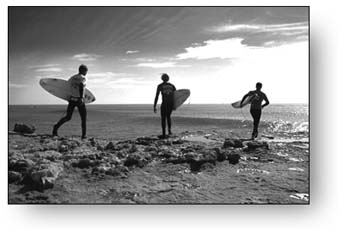
Christopher Gardner![[line]](/gifs/line.gif)
surfer, the bacteria will.
keyboard to surfboard.![[line]](/gifs/line.gif)
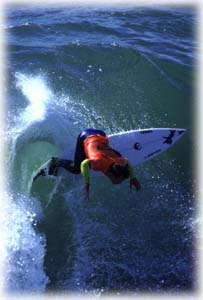 THE very nature of surfing lends itself to confrontations. Surfing is a completely unregulated sport. Surfers do not purchase tickets and agree to a set of rules before going out. There are no officials in or out of the water to referee problems. Lifeguards patrol beaches where people swim, not surf. Surfers just paddle out and go for it. All arguments are settled immediately, either in the water or on the beach.
THE very nature of surfing lends itself to confrontations. Surfing is a completely unregulated sport. Surfers do not purchase tickets and agree to a set of rules before going out. There are no officials in or out of the water to referee problems. Lifeguards patrol beaches where people swim, not surf. Surfers just paddle out and go for it. All arguments are settled immediately, either in the water or on the beach.
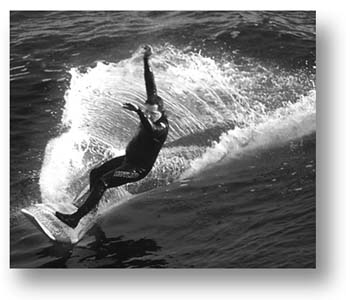
Christopher Gardner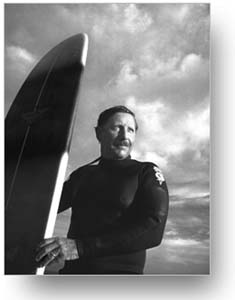
Surf Master: Longtime surfer Chuck Reed reposted surfing rules at Steamers Lane to ease tensions.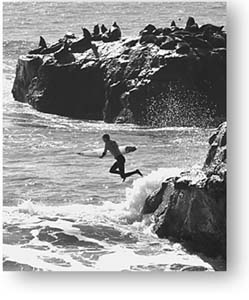 I RE-ENTERED the sport of surfing last year. I live and work within 10 minutes of Steamers, and the pull of the waves was just too strong to ignore. Say what you will about Santa Cruz, it has some of the best waves in the world. One day I walked into a surf shop and ordered a new 7-foot, 10-inch stick. Then I hit the O'Neill shop and picked up a 3.3 mm wetsuit. Toss in a pair of booties and a board cord, and the whole affair set me back about $650.
I RE-ENTERED the sport of surfing last year. I live and work within 10 minutes of Steamers, and the pull of the waves was just too strong to ignore. Say what you will about Santa Cruz, it has some of the best waves in the world. One day I walked into a surf shop and ordered a new 7-foot, 10-inch stick. Then I hit the O'Neill shop and picked up a 3.3 mm wetsuit. Toss in a pair of booties and a board cord, and the whole affair set me back about $650.
From the February 20-26, 1997 issue of Metro